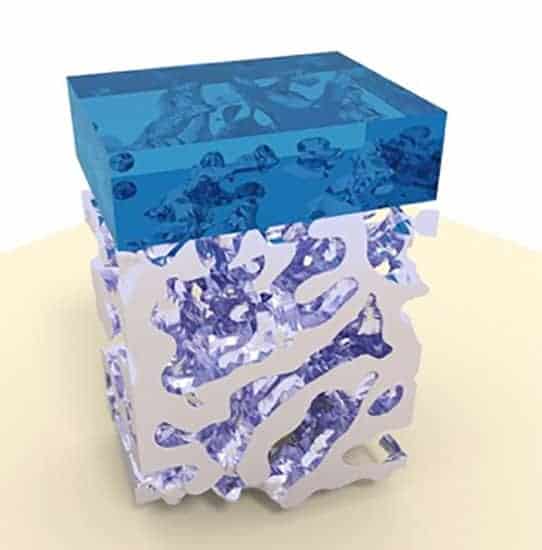
A new way of producing structural colours – inspired by the nanoporous feathers of a brightly coloured South American bird – has been developed by researchers in the US, Switzerland and Saudi Arabia. The technique relies on a self-assembling, random network of sub-wavelength pores in a metallic alloy to produce a wide-range of colours. According to the researchers, their technique is more robust and easier to scale up for commercial fabrication, and could be used in a range of applications including lightweight coatings for cars and aircraft.
Animals use colours for a range of functions, from courtship displays to camouflage. While many of these colours are produced by pigments, others are produced by surface structures that interact with light and reflect specific wavelengths. Researchers have long been interested in such structural colouration because of its durability and many potential applications.
“Pigments fade away over relatively short times, while structural colouration can persist over time, as it is based on a structure,” explains Andrea Fratalocchi, an engineer at the King Abdullah University of Science and Technology in Saudi Arabia. “Beetle fossils from millions of years ago still preserve the colours.” He adds that as structural colours can be dynamically changed via structural alterations, they could be used for novel smart materials with adaptive camouflage properties. So far, the real-world applicability of surfaces engineered with photonic crystals or metamaterials to produce structural colours has been limited, however, due to issues with robustness, cost and scalability.
Vibrant feathers
Much of the structural colour in nature is also produced by photonic crystals or highly ordered arrays of nanofibres, but the plum-throated cotinga (Cotinga maynana), is different. The tropical bird’s vibrant blue feathers are produced by a disordered nanoporous network of keratin. The network of pores, which are typical smaller than 200 nm, interacts with light in such a way that only certain wavelengths of blue light are reflected.
To create a similar nanoporous network in a platinum–aluminium-based alloy, Fratalocchi and colleagues at ETH Zürich and Harvard University used a de-alloying process. They placed the alloy on a suitable substrate and then immersed it in a sodium-hydroxide solution. This removed most of the aluminium, leaving the platinum to form a porous network.
Lead researcher Henning Galinski, a physicist at ETH Zürich and Harvard University, told Physics World that the feathers and the porous metallic alloy share “the same design idea”, featuring sub-wavelength structures and being “achieved by self-assembly”. He adds, “The main difference is that the continga feather barbs are made of keratin.”
Yellow to blue
To control the colour produced, the porous alloy was coated with an ultra-thin, transparent layer of aluminium oxide. Without this covering, the material appears dark. But when the coating was added and increased in thickness, the colour changed, transitioning from yellow to orange, red and, finally, blue.
“Our networks seem disordered and random, but from a network perspective, they are pretty regular, meaning that each nanowire or strut in the network is, on average, connected to the same number of nanowires,” explains Galinski. “The connectivity can be controlled by changing the fabrication process. In this work, we decided to keep the connectivity constant and alter the interaction of light with the material by adding an ultra-thin ceramic layer.” He adds: “Increasing this layer step-wise from 7 nm to 53 nm, allowed us to enhance the coupling for a specific wavelength of light, resulting in the formation of vibrant structural colour.”
The researchers found that when light hits the surface of their material, it couples with surface plasmons – collective excitations of electrons – that then become trapped in the disordered surface. This creates regions where the electrical permittivity is near zero, separated by areas of high refractive index. The aluminium-oxide film changes these dynamics and increases the reflection of different wavelengths of light, depending on its thickness.
Simple chemistry
Galinski explains that because the technique is “based on simple wet-chemistry and coating technologies”, it can “produce robust colours on large spatial scales”. Fratalocchi adds: “Previous approaches focus on creating structural colours by assembling arrays of identical building blocks, or unit cells. This approach works only on very small scales, and is totally unsuitable for industrial and large-scale applications. Our material, conversely, is based on disorder, and at is totally scalable, opening this technology to real-world, commercial applications.”
Galinski says that structural colours have “wide potential as a future printing technology for various applications, ranging from bio-mimetic tissues to adaptive camouflage materials”. He adds that as the described technique is mechanically robust and extremely lightweight, it is “suitable for real-world industrial applications, such as automotive vehicles or airplanes, for which the weight is directly related to the fuel economy”.
The new material is described in Light: Science & Applications.



